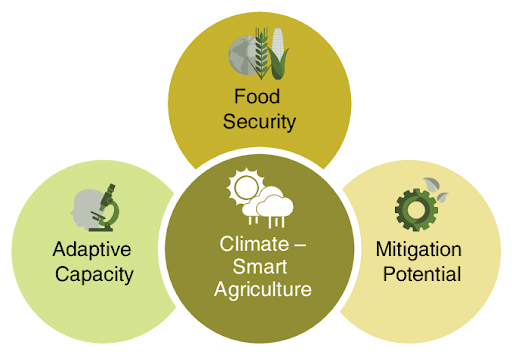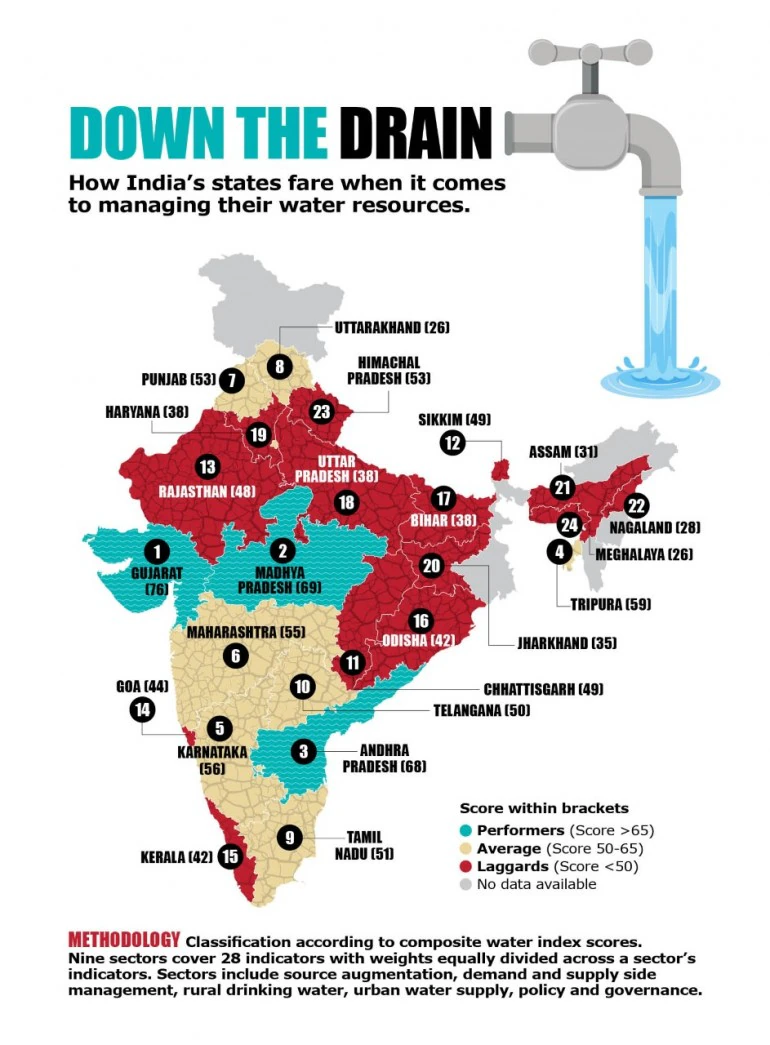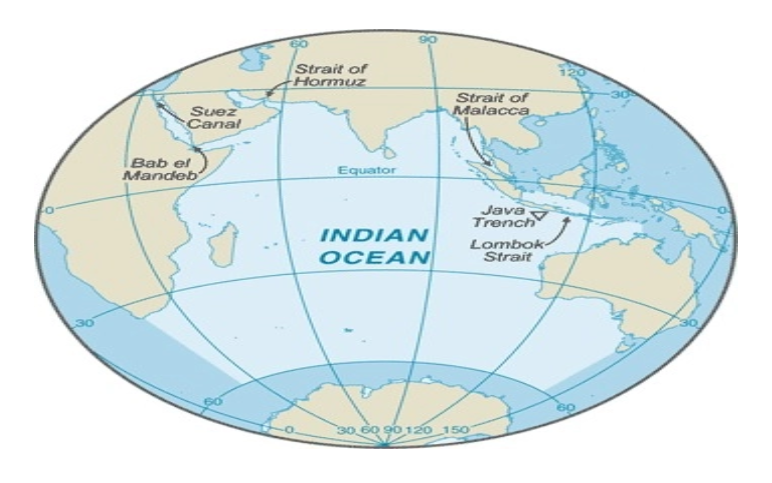24 Jul to 10 Aug, 2024
CRITICAL MINERALS : A NEW OIL FOR WORLD
Why in news : India is set to initiate its first offshore mineral auctions, representing a significant advancement in resource management. This effort, is a part of the proposed National Critical Minerals Mission (NCCM), seeks to strengthen the supply chain for critical minerals.
About :
Mineral Belts of India
1. Chotanagpur belt : This region is rich in coal, mica, manganese, chromite, ilmenite, bauxite, iron, uranium, phosphate, copper dolomite, chin-clay, and limestone. This region contains almost 100% of Kyanite reserves, 93% of Iron Ore, 84% of coal, and 70% of chromite of the country.
|
Chotanagpur Belt |
||
|
Jharkhand |
Odisha |
West Bengal |
|
Dhanbad, Hazaribagh, Palamu, Ranchi, Santhal-Pargana, and Singhbhum. |
Cuttack, Dhankenal, Kendujhar (Keonjhar), Koraput, Mayurbhanj, Sambhalpur, and Sundargarh. |
Bankura, Birbhum, Medinipur, and Purulia |
2. Midland Belt : Chhattisgarh, Andhra Pradesh, Madhya Pradesh and Maharashtra belt is rich in manganese ore, mica, bauxite, copper, graphite, limestone, lignite, and marble.
3. The Southern Belt : Andhra Pradesh, Telangana, Karnataka, and Tamil Nadu belt is rich in iron ore, gold, chromite, manganese, lignite, mica, bauxite, gypsum, asbestos, dolomite, ilmenite, chin-clay, and limestone.
4. Western Belt States: Rajasthan, Gujarat, and Maharashtra belt is rich in non-ferrous metals like copper, lead, zinc, uranium, mica, salt, manganese, asbestos, building stones, precious stones, etc.
5. South-Western Belt States: Goa, Karnataka, and Kerala contains the deposits of iron-ore, ilmenite, zircon, monazite sands, garnet, chin-clay, bauxite, mica, limestone and soapstone.
6. Himalayan Belt Regions: Himalayan Regions generally poor in metallic minerals. Copper, lead, zinc, bismuth, bauxite, antimony, nickel, cobalt, tungsten, gold, silver, gypsum, limestone, and dolomite are found in this region.
7. Indian Ocean Regions: The continental shelf of the Arabian Sea and Bay of Bengal, sea bed is rich in mineral oil, and natural gas. It also contains high grade nodules of manganese, phosphate, barium, aluminium, silicon, iron, titanium, sodium, potassium, chromium, monazite, ilmenite, magnetite and garnet.
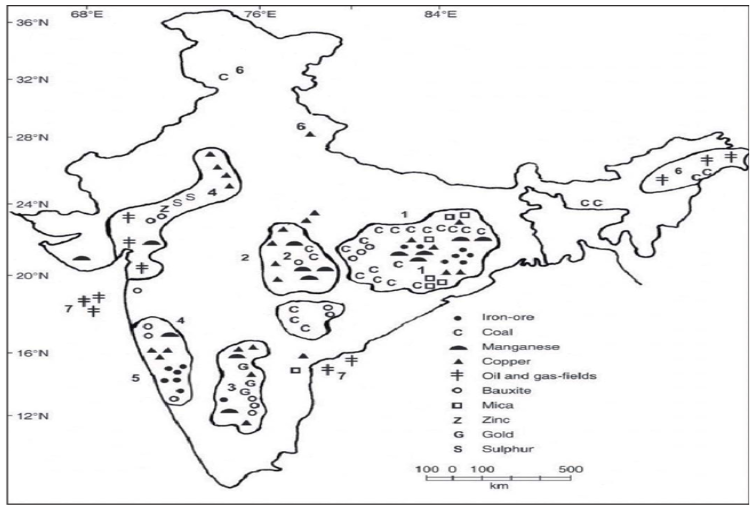
Geography of Offshore Mineral Resources of India
1. Continental Shelf and Slope : Extends up to 200 nautical miles from the coastline and rich in polymetallic nodules, hydrocarbons, and other valuable minerals.
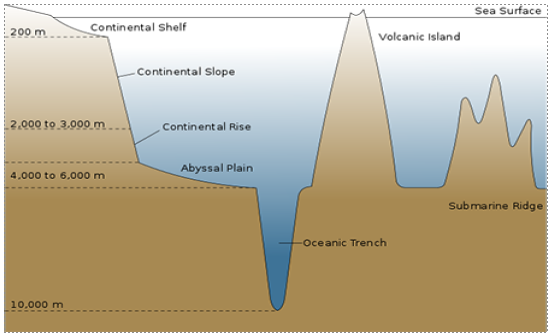
2. Exclusive Economic Zone (EEZ) : India's EEZ covers approximately 2.02 million square kilometers. A crucial area for exploration, as it holds vast reserves of untapped minerals. Key areas within the EEZ include the Arabian Sea, the Bay of Bengal, and the Andaman Sea.
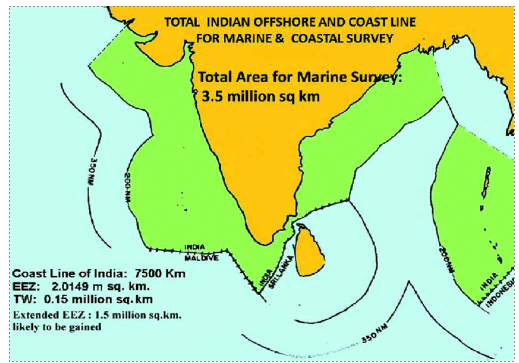
3. Underwater Plateaus and Basins : The Laccadive Plateau and the Andaman-Nicobar Basin are notable regions with significant mineral potential.
Minerals in Offshore of India
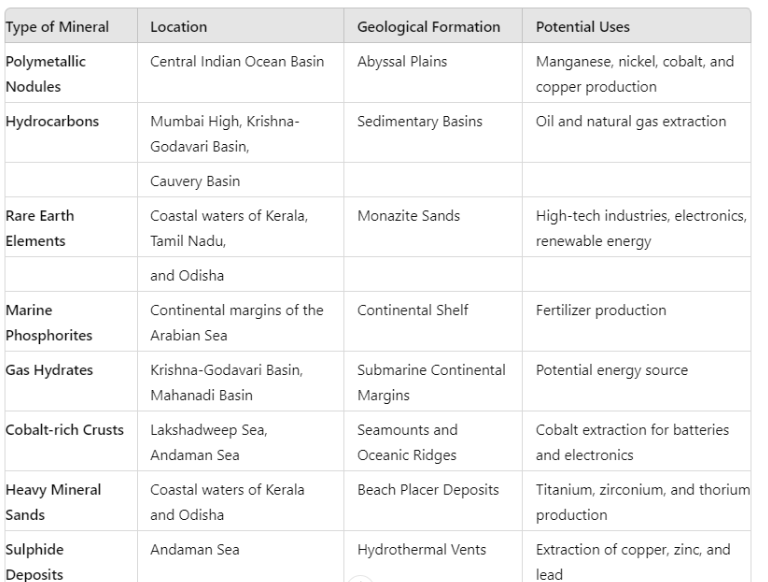
Significance
- Revenue Generation : Production level of important minerals in December, 2023 were: Coal 929 lakh, Lignite 40 lakh , Petroleum (crude) 25 lakh, Iron ore 255 lakh, Limestone 372 lakh tonnes each etc. Offshore resources are expected to add considerably to this figure as they are tapped into.
- Employment : In the hydrocarbon sector alone, the Krishna-Godavari Basin project has generated approximately 10,000 direct jobs and an estimated 30,000 indirect jobs.
- Technological Advancements: India's collaboration with Norway for deep-sea exploration, highlights the drive towards technological advancement.
- Impact on Global Mineral Market : India could become a key player in the global mineral market. This could reduce global dependence on China,and boost India's strategic importance.
- Global Supply chain : India's entry into the offshore mineral market could stabilize the global supply of critical minerals. This could mitigate the supply risks currently associated with the Democratic Republic of Congo (for cobalt) and Indonesia (for nickel).
- Sustainable Management of Mineral Resources: Government’s proposed National Critical Minerals Mission (NCCM) aims to ensure sustainable mining practices. The revenue from offshore hydrocarbons is already being used to fund renewable energy projects under India's National Solar Mission.
Challenges
- Threat to Marine Ecosystems: Offshore mining poses risks to sensitive marine ecosystems. A 2021 study by the National Institute of Oceanography (NIO) found that mining activities could lead to sediment plumes that smother benthic organisms and reduce biodiversity.
- Impact on Coastal Communities: Coastal communities could face displacement or changes to their traditional livelihoods due to offshore mining activities. Fishing communities in the Gulf of Mannar have raised concerns about potential disruptions to fish populations and their way of life.
- Technological Limitations: Offshore mining requires advanced technology for deep-sea exploration and extraction, including remotely operated vehicles (ROVs). India currently relies on international partnerships to access such technology, which can be expensive and subject to geopolitical influences.
Critical Minerals
Critical minerals, often referred to as the ‘new oil’, are essential for clean energy technologies such as solar modules, wind turbines, batteries, and transmission networks. The Ministry of Mines has identified 30 such minerals crucial for India's technological and renewable energy sectors.
The 30 Critical Minerals for India: Antimony, Beryllium, Bismuth, Cobalt, Copper, Gallium, Germanium, Graphite, Hafnium, Indium, Lithium, Molybdenum, Niobium, Nickel, Platinum Group Elements (PGE), Phosphorous, Potash, Rare Earth Elements (REE), Rhenium, Silicon, Strontium, Tantalum, Tellurium, Tin, Titanium, Tungsten, Vanadium, Zirconium, Selenium, Cadmium.
Significance of Critical Minerals
- Energy Transition and Electric Mobility : With India aiming for 30% electric vehicle penetration by 2030 (India’s EV Vision), secure access to these minerals is vital.
- Space Exploration and Satellite Technology: Rare earth elements and other critical minerals are essential for manufacturing high-performance magnets, specialized alloys, and advanced electronics used in satellites and spacecraft.
- Digital Economy and Telecommunications: The success of initiatives like Digital India and the rollout of 5G networks heavily depends on minerals such as gallium, indium, and tantalum.
Challenges of Critical Minerals
- Import Dependency : China's dominance in processing (67% of lithium, 73% of cobalt, 70% of graphite, and 95% of manganese) poses a significant risk to India's supply chain security.
- Missing Links in the Value Chain: India's limited capacity in processing and refining critical minerals presents a significant bottleneck.
- Price Volatility : Lithium prices have surged dramatically in recent years, affecting the economics of electric vehicle production.
India’s Global Partnership
- Global Partnerships : India has joined the Mineral Security Partnership (MSP) to represent developing countries vulnerable to global supply chain disruptions.
- Bilateral Agreements : Khanij Bidesh India Ltd (KABIL) has signed a $24 million lithium exploration and mining pact with Argentina for 5 lithium blocks.
- Multilateral Forums : India can leverage forums like the Quad, Indo-Pacific Economic Framework for Prosperity (IPEF), and European Critical Minerals Club to access minerals from other geographies.
Conclusion :
India has taken significant steps to strengthen its position in the global critical minerals value chain. A stable and progressive policy framework, combined with a large domestic market, can provide a competitive edge to Indian industries
Source : https://www.financialexpress.com/opinion/a-push-for-critical-minerals/3566179/
Where to use ?
Paper I ( General Studies ) : Minerals and their importance
Paper II ( Geography ) : Physical Setting and Resources
GULF STREAM MORE STRONGER DURING ICE AGE
Why in news : A recent study published in Nature has found that the Gulf Stream was much stronger during the last ice age, approximately 20,000 years ago, driven by more intense winds across the subtropical North Atlantic.
About :
The Gulf Stream is a strong ocean current that carries warm water from the Gulf of Mexico along the eastern coast of North America. It then flows across the Atlantic Ocean, affecting Western Europe's climate by making it warmer than it would be otherwise.
Recent Findings
- Research Methodology: To assess the prehistoric strength of the Gulf Stream, researchers analyzed fossilized foraminifera from sediment cores collected off the coasts of North Carolina and Florida. The findings revealed that during the last ice age, the Gulf Stream was both twice as deep and twice as fast as it is today.
- Impact on Climate: Despite the Gulf Stream's increased strength during the last ice age, the global climate was significantly colder than it is now. In the future, a weakened Gulf Stream could reduce the amount of tropical heat reaching Europe, potentially cooling the continent and causing sea levels to rise in North America.
- Role of Atlantic Meridional Overturning Circulation (AMOC): The Gulf Stream is an integral component of the AMOC, which is influenced by both deep water formation and wind patterns. Climate change, particularly the influx of glacial meltwater from Greenland, could weaken the AMOC. A weakened AMOC might lead to a temperature drop of 10 to 15 degrees Celsius in Europe, disrupt agricultural practices, and alter regional weather patterns.
- AMOC Loops and Climate Impact: The AMOC should be understood as a system of interconnected loops (subtropical and subpolar) rather than a simple conveyor belt. Different segments of the AMOC could respond differently to climate change, leading to varied climate impacts.
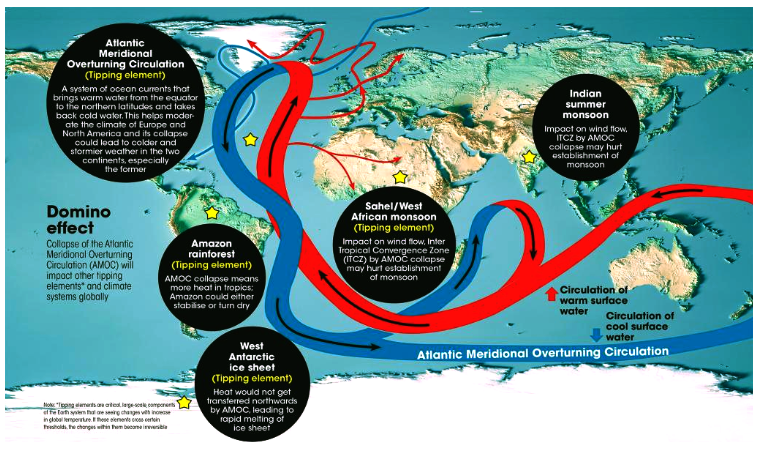
Source :
Where to use :
Paper I ( Geography Optional ) : Oceanography .
Paper I ( General Studies ) : Ocean Currents , AMOC, Impact of Climate Change on Currents
CLIMATE CHANGE AND CHILDREN VULNERABILITY
Why in news : Recently, a new report by the Global Education Monitoring Report of the United Nations Educational, Scientific and Cultural Organization (UNESCO) has highlighted the long-term impact of climate shocks experienced in early childhood.
About :
Key Findings of The Report
- Young children are particularly vulnerable to climate shocks due to their dependence on adults and their developing bodies.
- The immediate physical hazards of floods, droughts, and heatwaves pose significant risks, but the report also emphasizes the broader impact on cognitive abilities, emotional well-being, and educational opportunities.
Case Studies and Evidence : Several case studies illustrate the adverse effects of climate shocks on children:
- Ecuador: Children exposed to severe El Niño floods in utero were found to be shorter and performed worse on cognitive tests five to seven years later.
- India: Rainfall shocks experienced in utero negatively impacted vocabulary at age five and mathematics and non-cognitive abilities at age 15.
- Asia: An analysis of over 140,000 children in seven Asian countries found a negative relationship between early-life disasters and school enrollment and performance in mathematics, especially for girls.
- Several particular instances highlight the impact of natural disasters on education:
- 2013 Jakarta Floods: Disrupted access to schools, converted schools into emergency shelters, and led to school closures due to damage.
- Cyclone Idai (2019): Destroyed 3,400 classrooms in Mozambique, denying 305,000 children access to education.
- Tropical Cyclone Gita (2018): Damaged 72% of Tonga’s schools.
- Flood Exposure: Reduced completed grades among 12- to 15-year-olds in Ethiopia (3.4%), India (3.8%), and Vietnam (1.8%) due to household income loss.
- Heat Exposure: High temperatures negatively affected educational outcomes, as seen in China, where high-stakes test performance declined, leading to lower high school graduation and college entrance rates.
Long-Term Educational Outcomes
- Long-term educational outcomes are significantly affected by climate variability:
- Pakistan (2010 Floods): Children in flooded districts were 4% less likely to attend school compared to peers in non-flooded districts.
- Africa: Analysis of Demographic and Health Survey data from ten African countries revealed that low precipitation and drought conditions reduced primary school completion rates by 6.4%.
- India: Drought conditions in rural Maharashtra reduced children’s mathematics and reading scores by 4.1% and 2.7%, respectively.
Proactive Measures and Recommendations
- To mitigate the adverse effects of climate shocks on education, the report advocates for several proactive measures:
- Strengthening School Infrastructure: Schools should be built or retrofitted to withstand climate impacts.
- Training Educators: Teachers should be equipped to support students both psychologically and academically during climate-related challenges.
- Community Resilience: Initiatives should be undertaken to raise awareness and foster adaptation strategies within communities.
Source :
Where to use :
Paper I ( Geography Optional ) : Climatology
Paper 1 ( General Studies ) : Climate change and Global warming
Paper III ( General Studies ): Environment Conservation & Degradation
Thermohaline Circulation
Thermohaline Circulation : Thermohaline circulation, is an oceanic circulation that occurs due to differences in density based on temperature and salinity. In polar regions with lower temperatures, denser ocean water sinks and moves towards less dense middle and lower latitudes or equatorial regions.
Magnetofossils
Magnetofossils : Magnetofossils are fossilized remains of magnetic particles created by magnetotactic bacteria. Magnetotactic bacteria are prokaryotic organisms that align themselves along the Earth's magnetic field using tiny crystals made of iron-rich minerals like magnetite or greigite.
Dark Oxygen
Dark Oxygen : Oxygen that is being produced in complete darkness thousands of feet below the ocean surface is termed dark oxygen. Scientists found increased oxygen levels in the abyssal zone while studying the Clarion-Clipperton Zone. This increase was unexpected, as photosynthesis is not possible in these dark depths.
Maritime Domain Awareness
Maritime Domain Awareness : Maritime domain awareness (MDA) is defined by the International Maritime Organization as the effective understanding of anything associated with the maritime domain that could impact the security, safety, economy, or environment. It is one of the key components of maritime defence.
Biostimulants
Biostimulants : Biostimulants are defined as substances or microorganisms, or a blend of both, designed to stimulate plant physiological processes. They enhance nutrient uptake, growth, yield, nutritional efficiency, crop quality, and stress tolerance, irrespective of their nutrient content when applied to plants, seeds, or the rhizosphere.
URBAN AGGLOMERATION OF TRICITY
The Chandigarh-Panchkula-Mohali ( Sahibzaada Ajit Singh Nagar )region, commonly referred to as the "Tricity," is one of India's prominent urban agglomerations. The Tricity is well-connected by a network of highways, including National Highways NH-5, NH-7, and NH-152. Chandigarh has been selected under the Smart Cities Mission. Mohali is witnessing significant investment in IT and industrial parks, with initiatives like the Mohali IT City project. Panchkula's proximity to Chandigarh has also made it a preferred residential area.
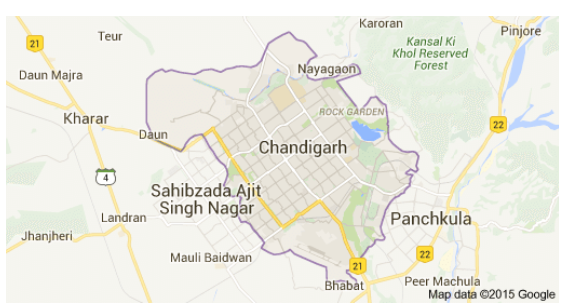
Source :
Where to use :
Paper I ( Geography Optional ) : Urban Agglomeration in Settlement Geography
Places in News - 10 August 2024
1. Amravati
Why in news : Recently, the Finance Minister announced Rs 15,000 crore in financial support for Andhra Pradesh to build its capital city, Amravati, and boost other development activities in the state.
- Amaravati is situated on the banks of the Krishna River in the Guntur district.
- The Amaravati Stupa is a famous historical monument in the area.
- The region also has natural attractions such as the Kondapalli Reserve Forest.
- Approx: Guntur
2. Mashkoh Valley
Why in news : Kargil Vijay Diwas is celebrated every year on July 26 to pay tribute to the bravery of Indian soldiers who made the ultimate sacrifice for the country during the Kargil War (1999).
- The Mashkoh Valley is situated in the Kargil district, part of the larger Ladakh region in northern India.
- It's also known as the "valley of wild tulips" and is a popular tourist destination.
- The valley is also home to the endangered Himalayan yew.
- The primary languages spoken in the region include Ladakhi and Urdu.
- Apprrox : Kargil
3. Jhajjar
Why in news : Recently, Manu Bhaker won a bronze medal in the women’s 10m air pistol event at the Paris 2024 Olympics.
- Jhajjar is a town in Jhajjar district in the Indian state of Haryana.
- It is a part of Delhi National Capital Region and situated on the road connecting Rewari to Rohtak
- Mainly Jhajjar is well known for a larger percentage of youngsters joining Indian Army.
- Approx : Rohtak
4. Ontigondlu
Why in news : Karnataka Chief Minister(CM) has highlighted the Mekedatu balancing reservoir project as a key solution to address water-sharing issues with Tamil Nadu during monsoon distress years, asserting that the project would benefit both states, particularly in times of water scarcity.
- Ontigondlu is the proposed reservoir site, situated at Ramanagara district in Karnataka about 100 km away from Bengaluru.
- It is the midst of the Cauvery Wildlife Sanctuary.
- The Karnataka government is likely to pressurise the Centre for approval of the construction of the Mekedatu Project on the Cauvery river.
- Approx : Bengaluru
5. Reasi
Why in news : India's efforts to secure domestic lithium resources have hit a roadblock as the Ministry of Mines cancelled the auction for a lithium block in Jammu and Kashmir's Reasi district for the second time.
- Reasi district is an administrative district in the Jammu division of Indian state of Jammu and Kashmir in the Jammu region.
- Major Hindu pilgrimage sites like Vaishno Devi, Shiv Khori, Baba Dhansar and Siyad Baba Waterfall are located in this district.
- Approx : Udhampur
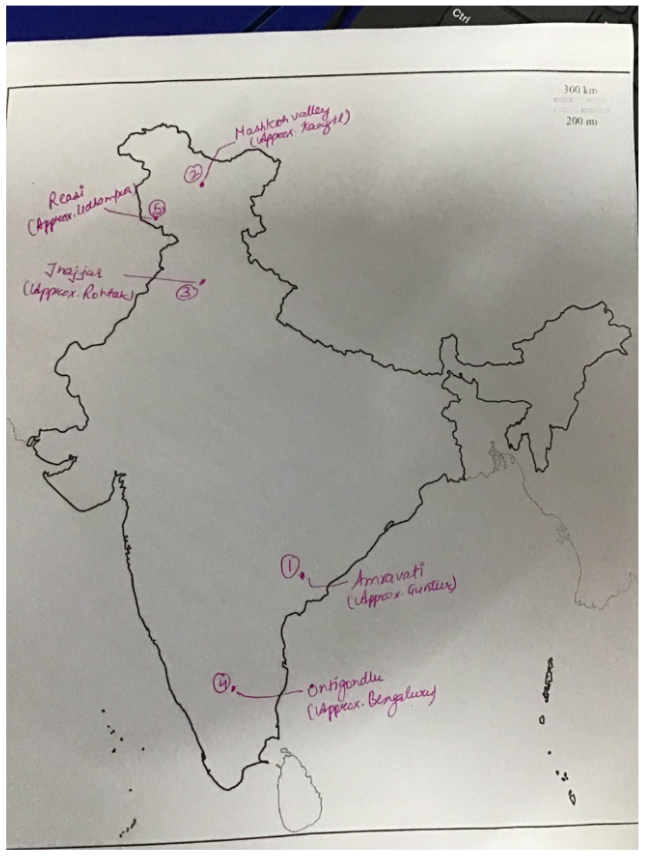
Fortnightly KOSMOS MCQs Practice
Q1. Consider the following statements regarding Paddy cultivation:
- Paddy is predominantly cultivated in regions with high humidity and temperatures ranging from 20°C to 30°C.
- The most widely used method for paddy cultivation is transplantation, where seeds are sown directly in the field.
Which of the statements given above is/are correct?
- Only 1
- Only 2
- Both
- None
Q2. Consider the following statements related to maize production in India,
- Karnataka, Madhya Pradesh, and Bihar are the leading states for maize cultivation.
- Bangladesh, Vietnam, and Nepal are significant markets for Indian maize.
- Maize can also serve as a substitute for rice in ethanol blending.
How many of the above statements is/are correct?
- One statement
- Two statements
- All three
- None
Q3. Consider the following statements regarding tiger conservation efforts:
- The Integrated Tiger Habitat Conservation Program (ITHCP), initiated in 2014, seeks to double the worldwide tiger population by 2030.
- The Global Tiger Forum (GTF), headquartered in New Delhi, is the sole international organization with members from multiple countries devoted to tiger conservation.
Which of the statements given above is/are correct?
- Only 1
- Only 2
- Both
- None
Q4. Consider the following statements regarding Particularly Vulnerable Tribal Groups (PVTGs):
- The Xaxa committee identified Primitive Tribal Groups (PTGs) as a unique category, which was later renamed PVTGs.
- Andhra Pradesh has the largest number of PVTGs, with Jharkhand following closely behind.
Select the correct answer using the code given below:
- Only 1
- Only 2
- Both
- None
Q5. With reference to World Environment Day, consider the following statements:
- The United Nations General Assembly (UNGA) established it to commemorate the opening day of the 1972 Stockholm Conference on the Human Environment.
- It is held annually by the World Wide Fund for Nature (WWF).
- The inaugural World Environment Day was celebrated with the theme "Land Restoration, Desertification, and Drought Resilience."
How many of the statements given above is/are correct?
- One statement
- Two statements
- All three
- None
Q6. Dark Oxygen recently in the news is most appropriately defined as:
- Oxygen generated by photosynthesis in shallow waters.
- Oxygen from the decomposition of organic matter in surface layers.
- Oxygen in the abyssal zone, beyond the reach of sunlight, potentially produced by polymetallic nodules.
- Oxygen trapped in ice, released as the ice melts.
Q7. Consider the following statements about the Meridional Overturning Circulation (MOC):
- It carries warm, salty water from the South Atlantic to the Nordic Seas.
- The complete circulation cycle of the MOC, known as the oceanic conveyor belt, is exceptionally fast.
Which of the above statements is/are correct?
- Only 1
- Only 2
- Both
- None
Q8. Consider the following statements about seaweeds:
- They are the most ancient flowering marine algae.
- Large seaweeds create dense underwater areas known as boreal forests.
- The Ministry of Fisheries, Animal Husbandry, and Dairying has established a seaweed park in Tamil Nadu.
Which of the statements given above is/are correct?
- 1 and 3 only
- 2 only
- 2 and 3 only
- 3 only
Q9. Consider the following statements related to Charles Darwin's Frog:
- They are members of the Dicroglossidae family.
- They also utilize artificial objects like plastic bags for breeding.
- They are presently classified as endangered on the IUCN Red List.
How many of the statements given above is/are correct?
- One statement
- Two statements
- All three
- None
Q10. With reference to Mangroves, consider the following statements:
- They are salt-tolerant trees and shrubs found in tropical and subtropical coastal regions.
- They thrive in areas where freshwater is clear of sediments and mud.
- Their seeds germinate while still attached to the parent tree.
Which of the statements given above is/are correct?
- 1 and 2 only
- 1 and 3 only
- 2 and 3 only
- 1, 2 and 3
Share the article
Edukemy’s Current Affairs Quiz is published with multiple choice questions for UPSC exams
MCQ
Get Latest Updates on Offers, Event dates, and free Mentorship sessions.

Get in touch with our Expert Academic Counsellors 👋
FAQs
Geography Current Affairs focuses on the contemporary issues, events, and developments in the field of geography. It covers recent geographical phenomena, environmental changes, geopolitical shifts, and related news. This differs from regular geography studies which may focus more on foundational concepts, historical contexts, and theoretical frameworks.
Updates are provided regularly to ensure that subscribers stay informed about the latest developments in geography. Typically, updates are provided on a fortnightly basis, depending on the frequency of significant events and changes in the field.
Absolutely. Geography Current Affairs serves as a valuable resource not only for Geography optional but also for GS papers, especially GS Paper 1 (covering Indian Heritage and Culture, History, and Geography of the World and Society) and GS Paper 3 (covering Technology, Economic Development, Biodiversity, Environment, Security, and Disaster Management). It aids in building a holistic understanding of various topics and strengthens answer-writing skills by incorporating contemporary examples and perspectives.
Geography Current Affairs holds immense importance for UPSC preparation, particularly for aspirants opting for Geography optional. It helps candidates stay updated with the latest developments, geographical phenomena, environmental issues, and geopolitical shifts worldwide, aligning them with the dynamic nature of the subject as tested in the UPSC examinations.

